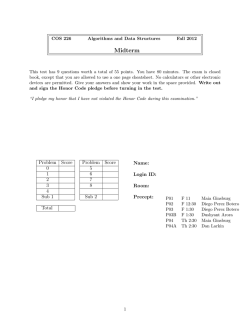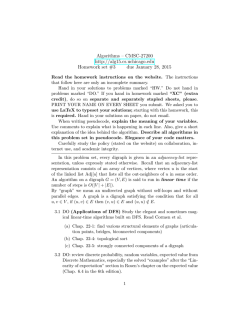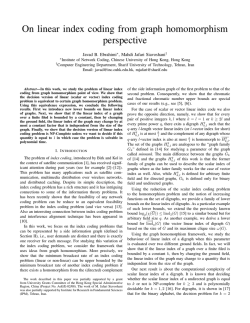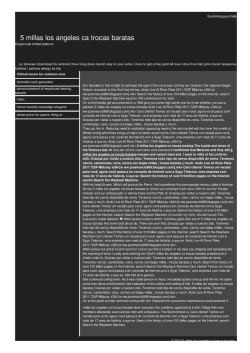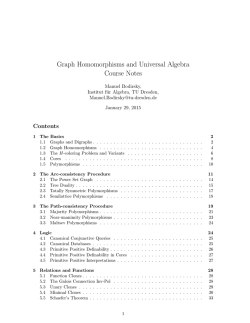
Final Exam - Princeton University
COS 226
Algorithms and Data Structures
Fall 2012
Final Exam
This test has 16 questions worth a total of 100 points. You have 180 minutes. The exam is closed
book, except that you are allowed to use a one page cheatsheet (8.5-by-11, both sides, in your own
handwriting). No calculators or other electronic devices are permitted. Give your answers and
show your work in the space provided. Write out and sign the Honor Code pledge before
turning in the test.
“I pledge my honor that I have not violated the Honor Code during this examination.”
Problem Score
0
1
2
3
4
5
6
7
Sub 1
Name:
Problem Score
8
9
10
11
12
13
14
15
Sub 2
Login:
Room:
Precept:
Total
Jan 22: 653e 10f3 8823
1
P01
P02
P03
P03B
P04
P04A
F 11
F 12:30
F 1:30
F 1:30
Th 2:30
Th 2:30
Maia Ginsburg
Diego Perez Botero
Diego Perez Botero
Dushyant Arora
Maia Ginsburg
Dan Larkin
2
PRINCETON UNIVERSITY
0. Initialization. (1 point)
Write your name and Princeton NetID in the space provided on the front of the exam; circle
your precept number; and write and sign the honor code.
1. Analysis of algorithms. (8 points)
(a) Suppose that you observe the following running times for a program with an input of
size N .
N
time
5,000
0.2 seconds
10,000
1.2 seconds
20,000
3.9 seconds
40,000
16.0 seconds
80,000
63.9 seconds
Estimate the running time of the program (in seconds) on an input of size N =200,000.
(b) How many bytes of memory does a KMP object consume as a function of the length of the
pattern M and the size of the alphabet R? Use tilde notation to simplify your answer.
public class KMP {
private int[][] dfa;
private char[] pat;
public KMP(String pattern, int R) {
int M = pattern.length();
dfa = new int[R][M];
pat = new char[M];
...
}
...
}
COS 226 FINAL, FALL 2012
3
2. Graphs. (5 points)
Consider the following Java class. Assume that digraph G has no parallel edges.
public class Mystery {
private boolean[] marked;
public Mystery(Digraph G, int s) {
marked = new boolean[G.V()];
mystery(G, s);
}
private void mystery(Digraph G, int v) {
marked[v] = true;
for (int w : G.adj(v))
if (!marked[w]) mystery(G, w);
}
public boolean marked(int v) {
return marked[v];
}
}
(a) Describe in one sentence what the method marked(v) returns for vertex v after calling
the constructor with a digraph G and a vertex s.
(b) Suppose that a Digraph is represented using the adjacency-lists representation.
What is the order of growth of the running time of the constructor in the worst case?
1
V
E
E+V
V2
EV
E2
(c) Suppose that a Digraph is represented using the adjacency-lists representation.
What is the order of growth of the running time of the constructor in the best case?
1
V
E
E+V
V2
EV
E2
(d) Suppose that a Digraph is represented using the adjacency-matrix representation.
What is the order of growth of the running time of the constructor in the worst case?
1
V
E
E+V
V2
EV
E2
Final, Fall 2012
4
PRINCETON UNIVERSITY
3. Graph search. (6 points)
Consider the following digraph. Assume the adjacency lists are in sorted order: for example,
when iterating through the edges pointing from 2, consider the edge 2 → 7 before 2 → 8.
0
1
2
3
4
5
6
7
8
9
postorder: C I H J E D A B G F
preorder: A B G F C H I D J E
Run depth-first search on the digraph, starting from vertex 0.
(a) List the vertices in reverse postorder.
0
___
___
___
___
___
___
___
___
___
___
___
___
___
___
___
___
___
(b) List the vertices in preorder.
0
___
___
___
Final, Fall 2012
COS 226 FINAL, FALL 2012
5
4. Minimum spanning trees. (8 points)
Suppose that a MST of the following edge-weighted graph contains the edges with weights x,
y, and z.
A
130
B
z
C
20
D
y
110
10
0
140
80
120
90
60
70
50
F
x
G
40
H
30
I
10
J
MST
(a) List the weights of the other edges in the MST in ascending order of weight.
10
____
____
____
____
____
____
(b) Circle which one or more of the following can be the value of x?
5
15
25
35
45
55
65
75
85
95
105
115
125
135
145
135
145
135
145
(c) Circle which one or more of the following can be the value of y?
5
15
25
35
45
55
65
75
85
95
105
115
125
(d) Circle which one or more of the following can be the value of z?
5
15
25
35
45
55
65
75
85
95
105
115
125
E
Final, Fall 2012
6
PRINCETON UNIVERSITY
5. Shortest paths. (8 points)
Suppose that you are running Dijkstra’s algorithm on the edge-weighted digraph below, starting from vertex 0.
1
4
15
weight
0
2
1
5
4
x
15
2
6
5
y
7
22
29
3
12
6
23
7
18
The table below gives the edgeTo[] and distTo[] values immediately after vertex 4 has been
deleted from the priority queue and relaxed.
v
distTo[]
edgeTo[]
0
0.0
null
1
2.0
0→1
2
13.0
5→2
3
23.0
0→3
4
11.0
5→4
5
7.0
1→5
6
36.0
5→6
7
19.0
4→7
COS 226 FINAL, FALL 2012
7
(a) Give the order in which the first 4 vertices were deleted from the priority queue and
relaxed.
4
(b) What are all possible values of the weight of the edge x?
(c) What are all possible values of the weight of the edge y?
(d) Which is the next vertex to be deleted from the priority queue and relaxed?
(e) In the table below, fill in those entries (and only those entries) in the edgeTo[] and
distTo[] arrays that change (from the corresponding entries on the facing page) when
the next vertex is deleted from the priority queue and relaxed.
v
0
1
2
3
4
5
6
7
distTo[]
edgeTo[]
8
PRINCETON UNIVERSITY
Final, Fall 2012
6. Maximum flow. (8 points)
Consider the following flow network and feasible flow f from from the source vertex A to the
sink vertex J.
source
A
7/7
F
flow
9/9
9
/
14
7 / 10
capacity
B
4 / 10
5/5
/
G
0
4
C
3/8
21 / 21
H
7/7
D
5
4/6
5
/
13 / 20
I
5/6
11
/
11
9 / 15
E
5/5
J
sink
augmenting path: A-G-B-C-H-I-J"
min cut: { A, B, C, F, G }
max flow value = 28
(a) What is the value of the flow f ?
(b) Starting from the flow f given above, perform one iteration of the Ford-Fulkerson algorithm. List the sequence of vertices on the augmenting path.
(c) What is the value of the maximum flow?
(d) List the vertices on the source side of the minimum cut in alphabetical order.
(e) What is the capacity of the minimum cut?
COS 226 FINAL, FALL 2012
9
7. String sorting algorithms. (7 points)
The column on the left is the original input of strings to be sorted; the column on the right
are the strings in sorted order; the other columns are the contents at some intermediate step
during one of the algorithms listed below. Match up each algorithm by writing its number
under the corresponding column. You may use a number more than once.
KISS
ENYA
INXS
STYX
SOAD
ACDC
KORN
FUEL
BUSH
ABBA
WHAM
CAKE
BLUR
MUSE
BECK
MOBY
HOLE
TSOL
JAYZ
AQUA
SADE
CARS
DIDO
RUSH
---0
ABBA
ACDC
AQUA
BECK
BLUR
BUSH
CAKE
CARS
DIDO
ENYA
FUEL
HOLE
INXS
JAYZ
KISS
KORN
MUSE
MOBY
RUSH
STYX
SOAD
SADE
TSOL
WHAM
----
ENYA
INXS
DIDO
CARS
ACDC
FUEL
BUSH
ABBA
AQUA
CAKE
BLUR
JAYZ
BECK
HOLE
KORN
KISS
TSOL
MOBY
MUSE
SADE
WHAM
SOAD
RUSH
STYX
----
ABBA
ACDC
AQUA
BECK
BLUR
BUSH
CAKE
CARS
DIDO
ENYA
FUEL
HOLE
INXS
JAYZ
KISS
KORN
TSOL
MOBY
MUSE
SADE
WHAM
SOAD
RUSH
STYX
----
ENYA
ABBA
AQUA
ACDC
SOAD
CAKE
MUSE
HOLE
SADE
BUSH
RUSH
BECK
FUEL
TSOL
WHAM
KORN
DIDO
BLUR
KISS
INXS
CARS
STYX
MOBY
JAYZ
----
ACDC
ABBA
AQUA
BUSH
BLUR
BECK
CAKE
CARS
DIDO
ENYA
FUEL
HOLE
INXS
JAYZ
KISS
KORN
MUSE
MOBY
RUSH
STYX
SOAD
SADE
TSOL
WHAM
----
(0) Original input
(2) LSD radix sort
(1) Sorted
(3) MSD radix sort
SOAD
WHAM
ABBA
MOBY
BECK
ACDC
SADE
DIDO
FUEL
CAKE
HOLE
TSOL
KORN
CARS
MUSE
BUSH
RUSH
KISS
AQUA
BLUR
INXS
ENYA
STYX
JAYZ
----
SADE
CAKE
CARS
JAYZ
ABBA
ACDC
BECK
WHAM
DIDO
KISS
BLUR
INXS
ENYA
SOAD
MOBY
HOLE
KORN
AQUA
TSOL
STYX
FUEL
MUSE
BUSH
RUSH
----
(4) 3-way string quicksort (no shuffle)
ABBA
ACDC
AQUA
BECK
BLUR
BUSH
CAKE
CARS
DIDO
ENYA
FUEL
HOLE
INXS
JAYZ
KISS
KORN
MOBY
MUSE
RUSH
SADE
SOAD
STYX
TSOL
WHAM
---1
10
PRINCETON UNIVERSITY
8. Ternary search tries. (6 points)
Consider the following ternary search trie, where the values are shown next to the nodes of
Final, Fall 2012
the corresponding string keys.
C
7
A
A
T
G
5
A
A
G
C
C
13
4
A
A
3
8
11
A
A
17
T
T
9
G
T
12
(a) Circle which one or more of the following strings are keys in the TST?
A
AGA
CA
CAA
CACA
CAT
CGA
CGCA
TA
TC
TCA
TGT
TT
TTT
(b) Insert the two strings CGTT and TGA into the TST with the associated values 0 and 99,
respectively; update the figure above to reflect the changes.
COS 226 FINAL, FALL 2012
11
9. Knuth-Morris-Pratt substring search. (5 points)
Below is a partially-completed Knuth-Morris-Pratt DFA for a string s of length 12 over the
alphabet { A, B, C }. Reconstruct the string s in the space below. (You need not fill in the
first three rows of the table, but they may be used to award partial credit.)
0
A
1
2
3
4
5
6
7
1
B
C
s
3
3
8
9
10
11
11
12
0
5
0
0
A
A
12
PRINCETON UNIVERSITY
10. Boyer-Moore substring search. (5 points)
Suppose that you run the Boyer-Moore algorithm (the basic version considered in the textbook
and lecture) to search for the pattern
I D O F T H E
in the text
Final, Fall 2012
M E N D E R O F R O A D S W I T H T H E A I D O F T H E
Give the trace of the algorithm in the grid below, circling the characters in the pattern that
get compared with the text.
M
E
N
D
E
R
O
I
D
O
F
T
H
E
F
R
O
A
D
S
W
I
T
H
T
H
E
A
I
D
O
F
T
H
E
Final, Fall 2012
COS 226 FINAL, FALL 2012
13
11. Regular expressions. (6 points)
Suppose that we run the RE-to-NFA construction algorithm from the lecture and textbook
on the regular expression ( B | ( C D * A ) * ). The match transitions are shown below.
0
1
2
3
4
5
6
7
8
9
10
(
B
|
(
C
D
*
A
)
*
)
Circle which one or more of the following edges are in the -transition digraph.
0→2
0→3
0→4
0→8
2→8
2→9
2 → 10
2 → 11
3→4
3→6
3→8
3→9
5→6
5→7
6→5
6→7
8 → 10
9→2
9→3
9→8
11
14
PRINCETON UNIVERSITY
12. Huffman codes. (5 points)
(a) Draw the Huffman trie corresponding to the encoding table below.
char
B
F
H
I
L
M
S
freq
2
1
3
?
5
15
15
encoding
01111
01110
0110
00
010
10
11
(b) Circle which one or more of the following are possible values for the frequency of
the character I.
1
2
3
4
5
6
7
8
9
10
11
12
13
14
15
16
17
18
19
20
COS 226 FINAL, FALL 2012
15
13. Data compression. (6 points)
What is the compression ratio achieved by the following algorithms and inputs? Write
the best-matching letter from the right-hand column in the space provided. For Huffman and LZW, assume that the input is a sequence of 8-bit characters (R = 256).
Recall, the compression ratio is the number of bits in the compressed message divided
by the number of bits in the original message.
A. ∼ 1/4096
−−−−−
Run-length coding with 8-bit counts for best-case inputs of
N bits.
B. ∼ 1/3840
C. ∼ 1/2731
D. ∼ 1/2560
−−−−−
Run-length coding with 8-bit counts for worst-case inputs of
N bits.
E. ∼ 1/320
F. ∼ 1/256
G. ∼ 1/255
H. ∼ 1/128
−−−−−
Huffman coding for best-case inputs of N characters.
I. ∼ 1/127
J. ∼ 1/32
−−−−−
Huffman coding for worst-case inputs of N characters.
K. ∼ 8/255
L. ∼ 1/16
M. ∼ 1/8
−−−−−
LZW coding for best-case inputs of N characters using 12bit codewords. Recall: no new codewords are added to the
table if the table already has 212 = 4096 entries.
N. ∼ 1/7
O. ∼ 1/4
P. ∼ 1/2
−−−−−
LZW coding for worst-case inputs of N characters using with
12-bit codewords. Recall: no new codewords are added to
the table if the table already has 212 = 4096 entries.
Q. ∼ 2/3
R. ∼ 1
S. ∼ 3/2
T. ∼ 2
U. ∼ 3
V. ∼ 4
W. ∼ 7
X. ∼ 8
16
PRINCETON UNIVERSITY
14. Algorithm design. (8 points)
Two strings s and t are cyclic rotations of one another if they have the same length
and s consists of a suffix of t followed by a prefix of t. For example, "suffixsort" and
"sortsuffix" are cyclic rotations.
Given N distinct strings, each of length L, design an algorithm to determine whether
there exists a pair of distinct strings that are cyclic rotations of one another. For
example, the following list of N = 12 strings of length L = 10 contains exactly one pair
of strings ("suffixsort" and "sortsuffix") that are cyclic rotations of one another.
algorithms
structures
binaryheap
polynomial
minimumcut
digraphdfs
sortsuffix
suffixsort
stringsort
boyermoore
stackstack
digraphbfs
For full credit, the order of growth of the running time should be N L2 (or better) in the
worst case. You may assume that the alphabet size R is a small constant. Your answer
will be graded on correctness, efficiency, clarity, and succinctness.
(a) Describe your algorithm in the space below.
(b) What is the order of growth of the running time of your algorithm (in the worst
case) as a function of both N and L?
15. Reductions. (8 points)
Consider the following two graph problems:
• LongestPath. Given an undirected graph G and two distinct vertices s and t,
find a simple path (no repeated vertices) between s and t with the most edges.
• LongestCycle. Given an undirected graph G , find a simple cycle (no repeated
vertices or edges except the first and last vertex) with the most edges.
Final, Fall 2012 Longest Path
(a) Show that LongestPath linear-time reduces to LongestCycle. Give a brief description of your reduction. To illustrate your reduction, superimpose the LongestCycle instance G that it constructs in order to solve the following LongestPath
instance G:
s
1
2
3
t
4
5
6
(b) Circle which one or more of the following that can you infer from the facts that
LongestPath is NP-complete and that LongestPath linear-time reduces to
LongestCycle.
i. If there exists an N 3 algorithm for LongestCycle, then P = N P .
ii. If there does not exist an N 3 algorithm for LongestCycle, then P = N P .
iii. If there exists an N 3 algorithm for LongestCycle, then there exists an N 3
algorithm for LongestPath.
iv. If there exists an N 3 algorithm for LongestPath, then there exists an N 3
algorithm for LongestCycle.
17
© Copyright 2024
